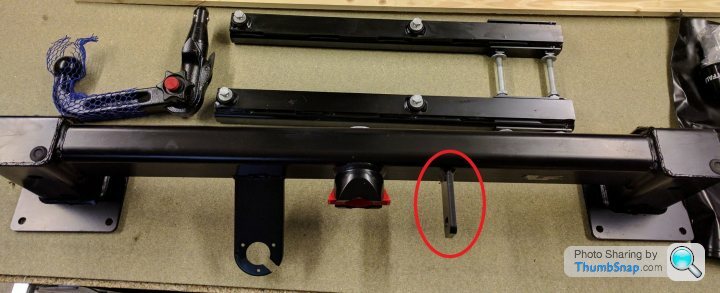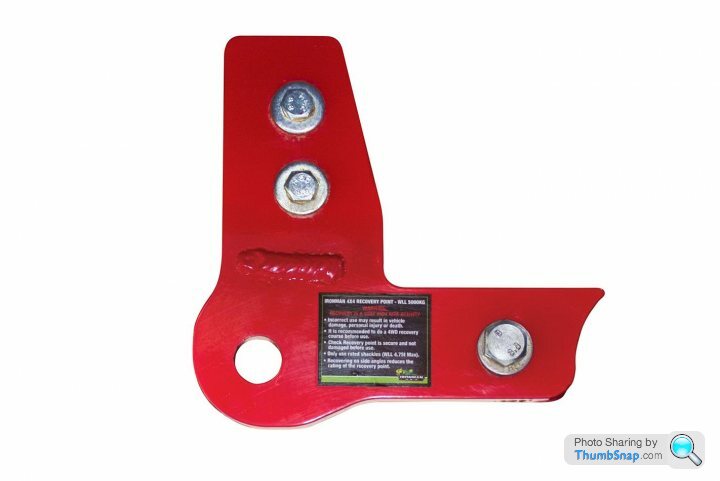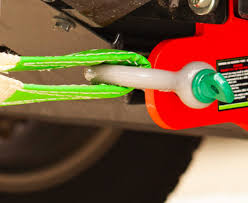Westfalia towbar recovery point?
Discussion
Mercedes GL
I understand I shouldn't use a towbar hook for a "snatch" type of recovery but the towbar structure does come with a large plate welded on which I think would do the job. I am not talking about recovery from anything particularly spectacular, but in case I need to be pulled back out of a hedge or snowdrift (I'm driving into the Arctic circle in a few weeks), would this plate be up to the job?
If it is, I'll need to cut out my bumper to expose it.

I'd rather use something a little more manly than the screw-in towing eye. I doubt that is up to doing anything other than winching the car onto a recovery truck, and would be very intolerant of forces at an angle.
I understand I shouldn't use a towbar hook for a "snatch" type of recovery but the towbar structure does come with a large plate welded on which I think would do the job. I am not talking about recovery from anything particularly spectacular, but in case I need to be pulled back out of a hedge or snowdrift (I'm driving into the Arctic circle in a few weeks), would this plate be up to the job?
If it is, I'll need to cut out my bumper to expose it.

I'd rather use something a little more manly than the screw-in towing eye. I doubt that is up to doing anything other than winching the car onto a recovery truck, and would be very intolerant of forces at an angle.
Personally I'd use the tow bar over the piece of metal you've highlighted.
I believe the guidance to avoid snatch recoveries using the towbar is because you're potentially putting huge loads into the 'cross member' (not the correct word but I'm sure you understand my intent) from a very off centre angle.
As long as you restrict yourself to the kind of gentle 'tug out of a ditch' type recovery you describe I wouldn't think twice about using the towbar. The advice against it is anticipating a full on snatch recovery of a vehicle up to its axles in mud; that wouldn't be sensible.
I believe the guidance to avoid snatch recoveries using the towbar is because you're potentially putting huge loads into the 'cross member' (not the correct word but I'm sure you understand my intent) from a very off centre angle.
As long as you restrict yourself to the kind of gentle 'tug out of a ditch' type recovery you describe I wouldn't think twice about using the towbar. The advice against it is anticipating a full on snatch recovery of a vehicle up to its axles in mud; that wouldn't be sensible.
Thanks for the advice.
The picture I posted is of mine before I installed it some 3 years ago, so I'm rather stuck with it now. However, my reticence in using the tow hook comes from the advice of some Australian YouTubers I follow who are dead set against using the tow ball but theirs are very different to mine and others in the UK. Theirs bolt onto a piece of steel that fits in their receiver and it seems that bolt is a potential sheer point. Mine does look massively more... erm, massive than theirs but I guess if it did sheer then there would be more mass flying through the air.
But you're right that "sensible" use should be OK. Those Australians do that "snatch" pull very aggressively. If I thought I might need that, I suspect recovery might be the least of my problems.
My whole towbar infrastructure is rated (for conventional towing) above the car's capability, and that's 3500Kg. It looks (and weighs) like it came from a bridge construction site. It will certainly be easier not to cut the bumper to expose that shackle plate.
Thanks again.
The picture I posted is of mine before I installed it some 3 years ago, so I'm rather stuck with it now. However, my reticence in using the tow hook comes from the advice of some Australian YouTubers I follow who are dead set against using the tow ball but theirs are very different to mine and others in the UK. Theirs bolt onto a piece of steel that fits in their receiver and it seems that bolt is a potential sheer point. Mine does look massively more... erm, massive than theirs but I guess if it did sheer then there would be more mass flying through the air.
But you're right that "sensible" use should be OK. Those Australians do that "snatch" pull very aggressively. If I thought I might need that, I suspect recovery might be the least of my problems.
My whole towbar infrastructure is rated (for conventional towing) above the car's capability, and that's 3500Kg. It looks (and weighs) like it came from a bridge construction site. It will certainly be easier not to cut the bumper to expose that shackle plate.
Thanks again.
I was taught, by somebody whose opinion I trust in these matters, that we shouldn’t use the tow ball for recovery as it’s strength is primarily designed to withstand the vertical/downward force generated by the weight of the trailer and not the horizontal forces generated in a recovery. This makes sense to me so I’m still to be convinced it would be a good idea.
Edited by Rudolph Hart on Wednesday 15th January 19:29
Rudolph Hart said:
I was taught, by somebody whose opinion I trust in these matters, that we shouldn’t use the tow ball for recovery as it’s strength is primarily designed to withstand the vertical/downward force generated by the weight of the trailer and not the horizontal forces generated in a recovery. This makes sense to me so I’m still to be convinced it would be a good idea.
That's an opinion I've heard before but I believe the reality is quite the opposite. Tow ball tongue weight is quite light in the EU compared with the US and Australia. One reason is because our trailers tend to have their wheels located centrally. However, a 2.5 tonne horsebox exerts quite a lateral jolt when driving over speed bumps - you get pulled and pushed forwards and backwards in your seat even inside my 2.5 tonne car. Edited by Rudolph Hart on Wednesday 15th January 19:29
The tow hook on mine is forged and it's significantly heavy but I am still cautious about using it for recovery purposes as described above. I am going to see what it would take to expose the plate but I've been thinking more about this. To make it work properly I think I'd have to allow enough room to insert my tow strap shackle, and then to allow the shackle to move side to side, which may require my cutting a significant piece of the bumper away... which I don't fancy.
I'll have a look inside the bumper over the weekend.
HustleRussell said:
Wait... tell us again why you wouldn’t use the factory towing eye which was surely designed in and engineered for exactly this purpose?
The screw in towing eye is not designed for this purpose. I have seen one pull out from a Golf once - the towing car pulled away a little too sharpish and tore it straight out. And I've seen one bent from an off-axis pull. Both are scenarios I might find myself in. Plus, 2.5 tonne car. The towing eye on mine is no different to the one supplied with a C-class.Watchman said:
SlimJim16v said:
Nope, that plate's not really strong enough and has no sideways bracing. It would need reinforcing, so you may as well have proper ones added.
I did wonder. What do you think it's for? Could it be for a safety chain or some sort of anti jack knife device?Watchman said:
HustleRussell said:
Wait... tell us again why you wouldn’t use the factory towing eye which was surely designed in and engineered for exactly this purpose?
The screw in towing eye is not designed for this purpose. I have seen one pull out from a Golf once - the towing car pulled away a little too sharpish and tore it straight out. And I've seen one bent from an off-axis pull. Both are scenarios I might find myself in. Plus, 2.5 tonne car. The towing eye on mine is no different to the one supplied with a C-class.An elasticated towing rope would probably help reduce the risk of damage?
HustleRussell said:
Watchman said:
SlimJim16v said:
Nope, that plate's not really strong enough and has no sideways bracing. It would need reinforcing, so you may as well have proper ones added.
I did wonder. What do you think it's for? Could it be for a safety chain or some sort of anti jack knife device?HustleRussell said:
Watchman said:
HustleRussell said:
Wait... tell us again why you wouldn’t use the factory towing eye which was surely designed in and engineered for exactly this purpose?
The screw in towing eye is not designed for this purpose. I have seen one pull out from a Golf once - the towing car pulled away a little too sharpish and tore it straight out. And I've seen one bent from an off-axis pull. Both are scenarios I might find myself in. Plus, 2.5 tonne car. The towing eye on mine is no different to the one supplied with a C-class.An elasticated towing rope would probably help reduce the risk of damage?
I have one of those semi elastic ropes - a 3" strap in fact. It's supposed to give a little but nothing like those kinetic ropes.
Watchman said:
Thank you. Wonder why it's so short. It would have been more useful if it had hung down a little more to clear the bumper.
I suppose that the idea is that you have an inconspicuous place to attach the breakaway cable, which unless something has gone horribly wrong will never be pulled taught- therefore it doesn’t need to clear the bumper. If the trailer has detached the bumper has presumably gotten mullered anyway. Also pretty much everybody including me just lazily loops the breakaway cable around the tow bar itself which is incorrect. Anyway if that’s what it’s for it’s probably engineered to take a load of, what? less than 1000kN? in a longitudinal direction- once.
HustleRussell said:
Watchman said:
Thank you. Wonder why it's so short. It would have been more useful if it had hung down a little more to clear the bumper.
I suppose that the idea is that you have an inconspicuous place to attach the breakaway cable, which unless something has gone horribly wrong will never be pulled taught- therefore it doesn’t need to clear the bumper. If the trailer has detached the bumper has presumably gotten mullered anyway. Also pretty much everybody including me just lazily loops the breakaway cable around the tow bar itself which is incorrect. Anyway if that’s what it’s for it’s probably engineered to take a load of, what? less than 1000kN? in a longitudinal direction- once.
The hook hangs out the bottom of the main cross member further than that plate does but of course the hook is removable. I think you're right that it was designed to look inconspicuous. It just makes it a bit useless too.
Right - thanks to you all. I know what I've got available to me now.
Watchman said:
When I fitted the tow bar originally, I didn't appreciate that's what that plate was for so I never cut the bumper to reveal it, and I have been doing what you said - looping to chains around the tow hook - ever since.
...but what if the tow bar comes off and takes the trailer with it?Tow bar manufacturers probably need to provide a dedicated attachment point for the breakaway cable for type approval. However, you, I and pretty much everybody else just loop the breakaway cable around the tow bar and don't want extra bits sticking out everywhere- hence the tow bar manufacturers probably stick it on there to satisfy the requirement but don't bother too much actually making it easy to use.
As long as you are NOT doing kinetic snatch recoveries I would use the the tow bar if its just a case of a straight pull. The safe working load of the tow bar will be at least 3.5 tons with a minimum breaking load of at least 3 times that so 10.5 tons. A normal tow rope is likely to be rated at 5 tons so is going to break well before the towbar will.
If you are really concerned and expect to have to be recovered often fit a properly rated recovery point to the chassis under the front and rear of the vehicle.


If you are really concerned and expect to have to be recovered often fit a properly rated recovery point to the chassis under the front and rear of the vehicle.


Edited by bigblock on Saturday 18th January 18:48
HustleRussell said:
Watchman said:
HustleRussell said:
Wait... tell us again why you wouldn’t use the factory towing eye which was surely designed in and engineered for exactly this purpose?
The screw in towing eye is not designed for this purpose. I have seen one pull out from a Golf once - the towing car pulled away a little too sharpish and tore it straight out. And I've seen one bent from an off-axis pull. Both are scenarios I might find myself in. Plus, 2.5 tonne car. The towing eye on mine is no different to the one supplied with a C-class.An elasticated towing rope would probably help reduce the risk of damage?
They are cheap, light and designed to meet the bare minimum of requirements which is to pull a car in a straight line on to a recovery truck or car transporter from a generally flat, level surface without any bogging down.
And a snatch recovery using a kinetic rope is a disaster (possibly including death or maiming) waiting to happen. The huge, sudden forces a kinetic rope can exert could simply pull the eye out or open up the loop of the eye.
bigblock said:
As long as you are NOT doing kinetic snatch recoveries I would use the the tow bar if its just a case of a straight pull. The safe working load of the tow bar will be at least 3.5 tons with a minimum breaking load of at least 3 times that so 10.5 tons. A normal tow rope is likely to be rated at 5 tons so is going to break well before the towbar will.
If you are really concerned and expect to have to be recovered often fit a properly rated recovery point to the chassis under the front and rear of the vehicle.


Definitely not doing kinetic recovery. I have a Rhino 10 ton tow strap and shackles. It is designed to allow for a "jerk" but not a kinetic type of recovery. If you are really concerned and expect to have to be recovered often fit a properly rated recovery point to the chassis under the front and rear of the vehicle.


Edited by bigblock on Saturday 18th January 18:48
I've seen those recovery points before but never really understood where I should mount them. Any advice?.. although I have reassured myself today that my tow hook will suffice for my purposes.
Thanks again.
Gassing Station | Off Road | Top of Page | What's New | My Stuff



